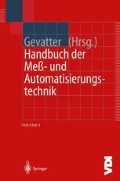Zusammenfassung
Masse ist eine Eigenschaft der Materie. Sie manifestiert sich durch die zwei zur Messung heranziehbaren Kraftwirkungen:
-
Massen ziehen sich an (Gravitationskraft → „schwere Masse”);
-
zur Änderung der Bewegung einer Masse ist eine „Beschleunigungskraft” erforderlich → „träge Masse”.
Access this chapter
Tax calculation will be finalised at checkout
Purchases are for personal use only
Preview
Unable to display preview. Download preview PDF.
Literatur
Wöhrl J (1988) Von Maß- und Waagensystemen zur Kreiselwaage sowie weitere Firmenschriften. Wöhwa-Gyroskop, Öhringen
1.2 VDI/VDE-Richtlinie 2638
Gevatter H (1992) Mikrobeschleunigungs-Sensorsystem mit analog/digitaler Meßwertverarbeitung. Schwerpunktprogramm „Sensorsysteme”. (Hg.: H Kunzmann), Abschlußkolloquium 13.–14.4.1994, PTB-Bericht. Braunschweig S 86–92
Maier R (1989) Integrated digital control and filtering for an electrodynamically compensated weighing cell. IEEE Trans. IM, Vol 38, No 5
Pfeiffer A (1994) Integrated H∞ design for filtering and control operations of a high-precision weighing cell. First asian control conf., Tokio
1.6 Firmenunterlagen. Sartorius, Göttingen
Bethe K (1990) Creep of sensor’s elastic elements. Sensors and actuators, A21-A23, S 844–849
Bergquist B (1986) Pilot tests to determine micro-elastic effects in load cell receptor materials. Proc. nth conf. of IMEKO-TC3, Amsterdam, S 313–322
Burbach J (1970) Unvermeidliche Einflüsse der Belastungsgeschwindigkeit auf die Anzeige von Lastzellen. VDI-Berichte Nr. 137, S 83–87
Bethe K (1980) Creep and adiabatic temperature effects in elastic materials. Proc. 8th Conf. of IMEKO-TC3, Krakau, S 101–104
Bethe K (1994) After-effects in load cells. Proc. XIII IMEKO world congress, Turin, S 223–228
Frank J (1991) Dickenabhängigkeit der elastischen Nachwirkung von dünnen Biegebalken. Dissertation, TU Braunschweig
Spoor M (1986) Improving creep performance of the strain gage based load cell. Proc. nth conf. of IMEKO-TC3, Amsterdam, S 2930–302
Schwarz H (1980) Methode der finiten Elemente. Teubner, Stuttgart
Tichy J (1980) Piezoelektrische Meßtechnik. Springer, Berlin Heidelberg New York
Schaumburg H (1992) Sensoren 3. Teubner, Stuttgart, S 200–205
Nordvall J (1984) New magnetoelastic load cells for high precision force measurement and weighing. Proc. 10th conf. of IMEKO-TC3, Kobe, S 5–9
Seekircher J (1990) New magnetoelastic force sensor using amorphous alloys. Sensors and actuators A21-A23, S 401–405
Buser R (1989) Theoretical and Experimental Investigations on Silicon Single Crystal Resonant Structures. Dissertation, Universität Neuchatel
Ueda T (1984) Precision force transducers using mechanical resonators. Proc. 10th conf. of IMEKO-TC3, Kobe, S 17–21
Jones B (1994) Dynamic characteristics of a resonating force transducer. Sensors and Actuators A41-A42, S 74–77
Ferrero C (1994) The new 0, 5 MN IMGC sixcomponent dynamometer. Proc. XIII IMEKO World congress, Turin, S 205–210
VDI/VDE-Richtlinie 2637 (in Neubearbeitung)
Kochsiek M (1988) Handbuch des Wagens. Vieweg, Braunschweig, S 724–744
Peters M (1993) Influences on the uncertainty of force standard machines with hydraulic multiplication. Proc. 13th conf. on force & mass (IMEKO-TC3), Helsinki, S 11–19
Jäger G (1983) Elektronische interferentielle Kraftsensoren und ihre Anwendung in Wägezellen. Feingerätetechnik 32, Berlin, S 243–245; sowie Vortrag PTB Braunschweig (1993)
Kreuzer M (1985) Moderne microcomputergesteuerte Kompensatoren. Meßtechnische Briefe (HBM) 21, S 35–38
Horn K (1989) Fast, precise and inexpensive AD-converters of a new time-division configuration for intelligent ohmic and capacitive sensors. Proc. IEEEConf. „CompEuro”, Hamburg, S 3.115–119
Ono T (1984) Dynamic mass measurement system of displacement and velocity sensing-type. Proc. 10th IMEKO-TC3 conf., Kobe, S 149–161
Horn K (1988) In: Handbuch des Wagens, Vieweg, Braunschweig; S 65–143
Zabler E (1994) A non-contact strain-gage torque sensor for automotive serve-driven steering systems. Sensors and Actuators A41-A42, S 39–46
Quass M (1995) Neues Meßprinzip revolutioniert die Drehmomentmeßtechnik. Antriebstechnik 34:4/76–80
Garshelis J (1992) Development of a non-contact torque transducer. SAE Technical paper 920 707, Detroit
Kabelitz H (1994) Entwicklung und Optimierung magnetoelastischer Sensoren und Aktuatoren. Dissertation, TU Berlin
Editor information
Editors and Affiliations
Rights and permissions
Copyright information
© 1999 Springer-Verlag Berlin Heidelberg
About this chapter
Cite this chapter
Bethe, K. (1999). Kraft, Masse, Drehmoment. In: Gevatter, HJ. (eds) Handbuch der Meß- und Automatisierungstechnik. VDI-Buch. Springer, Berlin, Heidelberg. https://doi.org/10.1007/978-3-662-07701-6_4
Download citation
DOI: https://doi.org/10.1007/978-3-662-07701-6_4
Publisher Name: Springer, Berlin, Heidelberg
Print ISBN: 978-3-662-07702-3
Online ISBN: 978-3-662-07701-6
eBook Packages: Springer Book Archive

